Where Is the Milky Way Galaxy? Best Viewing Tips
It’s worth knowing how to find the Milky Way because capturing the night sky is one of the most popular types of night photography. You can take some stunning photos by photographing the bright stars that form the Milky Way. But it’s not always easy.
Finding the Milky Way can seem daunting if you don’t know how. There are also many misconceptions about finding it in the night sky. This post aims to clear that up. Read on, and you’ll see that finding the Milky Way is much simpler than you think!
[highlight type=”short” price=”no” toc=”no” title=”Milky Way Mastery” badge=”Video Course” product=”30940″]Unlock the secrets of night sky photography with this video course:
- Learn to plan shots with optimal light, weather, and moon conditions.
- Discover the precise settings for stunning shots with any gear.
- Master simple editing techniques to enhance your night sky images.
[/highlight]
Locating the Milky Way: Best Tips
When we look up at a clear night sky, the Milky Way is everywhere. It’s the galaxy that contains the Solar System. From Earth, it’s seen as a hazy form of stars that the naked eye can barely notice.
You can see the Milky Way all year, no matter where you are. It’s visible as long as the sky is clear and there’s minimal light pollution. The Milky Way also appears to move in the sky as the Earth rotates!
Have a look at the two images below. The first was shot at about 1:00 a.m., and the second was shot at about 4:30 a.m.
The location is almost the same, but you’ll notice that the Milky Way appears to have moved. (Depending on the time of year and where you are, this may or may not be apparent.)
[imageblock]
[image src=”https://cdn.expertphotography.com/wp-content/uploads/2020/04/where-is-the-milky-way-1.00-am.jpg” alt=”The Milky Way above the silhouette of a rock formation” title=”1:00 am”]
[image src=”https://cdn.expertphotography.com/wp-content/uploads/2020/04/where-is-the-milky-way-4.30-am.jpeg” alt=”The Milky Way above a rock formation” title=”4:30 am”]
[/imageblock]
Locating the Galactic Way After Dusk
You find the Milky Way in all its glory only when all three sky conditions below are met. As mentioned, it also depends on where you are and the time of year. But to see the Milky Way at night, you generally only need the following:
- A clear, cloudless sky
- No light pollution
- A moonless night
1. Choose a Dark Evening With No Clouds
Because you need a clear sky, looking for the Milky Way during the summer is best. Check the weather and try to go out at night when the sky is clear, and there are no clouds. Aim for less than 10% cloud cover.
To help you out, Clear Sky Chart is a good resource for astronomers. It tells you when the sky will be clear and dark at specific observing sites. This includes national parks across North America.
2. Aim for Minimal Light Pollution
When looking for the Milky Way, it is important to go to a dark location far from the city. Light pollution is caused by the excessive artificial light in cities. This extra light reduces one’s ability to see stars.
Too much extra light washes out the details in the night sky. You may have to drive more than 150 miles from a big city until you reach a true dark sky. This distance is based on the Bortle Dark-Sky Scale. It measures the quality of astronomical observing conditions.
3. Plan for a Moonless Nighttime Canopy
The moon is brighter than you think and reduces the visible intensity of the Milky Way. If you are looking for the Milky Way on a night when the moon is shining bright, you won’t see it.
The sky has to be very dark to see the galaxy’s stars with your naked eye. The moon washes out the light of the stars, just like light pollution from cities does.
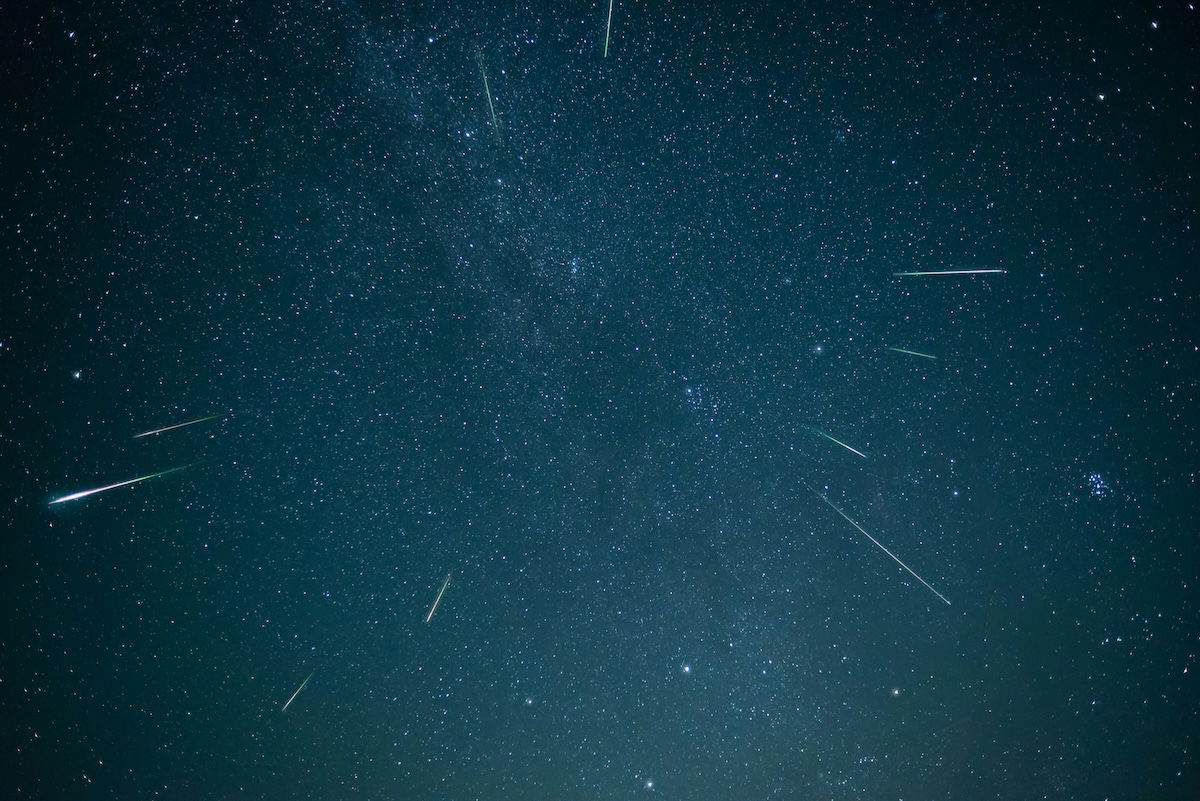
Shooting stars taken with a Nikon Z5. 24mm, f/1.8, 10 seconds, ISO 4,000. Sheng Hu (Unsplash)
Understand Moon Phases for Best Shooting Times
We all know how to check the weather. And finding an area with very little light pollution is simple enough. But understanding the moon’s phases is a little more complicated. It’s important to find the best times to see the Milky Way.
For the best results, we want to photograph the Milky Way during “full darkness.” That’s when there’s no moon to wash out the stars. Full darkness is at its longest during the new moon and winter months.
The best times to see the Milky Way are during new moons when the moon is completely hidden in the sky. You can also see it a week before or after a new moon. But if the moon is in its first quarter or more, the moonlight will be too bright to see it.
In the pictures below, you can see the duration of a new moon’s full darkness during spring in Iceland. It’s 12 hours and 46 minutes. Then, compare the same duration during the full moon. You’ll see the time has been reduced by 1 hour and 36 minutes.
For maximum photography time, take photos of the Milky Way during a new moon in the winter. As we’ll show you, those stars will disappear as soon as the astronomical dawn shows its face.
I track this using the Deluxe Moon and Sol apps (free and $4.99, screenshots below). You can read more about them in our article about apps for evening photography and capturing our galaxy.
[imageblock]
[image src=”https://cdn.expertphotography.com/wp-content/uploads/2020/04/where-is-the-milky-way-new-moon.png” alt=”Screenshots of the Deluxe Moon and Sol apps to find the Milky Way showing a new moon phase and times of full darkness in Iceland” title=”New Moon Full Darkness”]
[image src=”https://cdn.expertphotography.com/wp-content/uploads/2020/04/where-is-the-milky-way-full-moon.png” alt=”Screenshots of the Deluxe Moon and Sol apps to find the Milky Way showing a full moon phase and times of full darkness in Iceland” title=”Full Moon Full Darkness”]
[/imageblock]
Finding the Way of Milk: Essential Queries
These are the most commonly posed inquiries regarding the location of the Milky Way. We trust our responses will assist you in getting ready for your evening photoshoot.
What’s the Optimal Hour to View the Milky Way?
Different times at night also affect how you can see the Milky Way. So, it’s good to understand the various phases of the night. As the sun sets, the sky transitions into the golden hour and then the blue hour.
The exact sunset and sunrise are when the sun is zero degrees to the horizon. After sunset comes civil, then nautical, and lastly, astronomical twilight, when the sun is 18 degrees below the horizon. After this, the sky is the darkest they will ever be for the entire evening.
This time of transition, or twilight, can be divided into three phases. These phases depend on the angle of the sun (pictured below) and are civil twilight, nautical twilight, and astronomical twilight.
The best time to see the Milky Way is when it’s darkest, after astronomical twilight at dusk and before astronomical twilight at dawn. The longest duration is during the winter months.
When the sun begins to rise at dawn, the sky again goes through the three phases of twilight. But this time, it’s in reverse order. First comes astronomical, then nautical, and finally, civil twilight before sunrise.
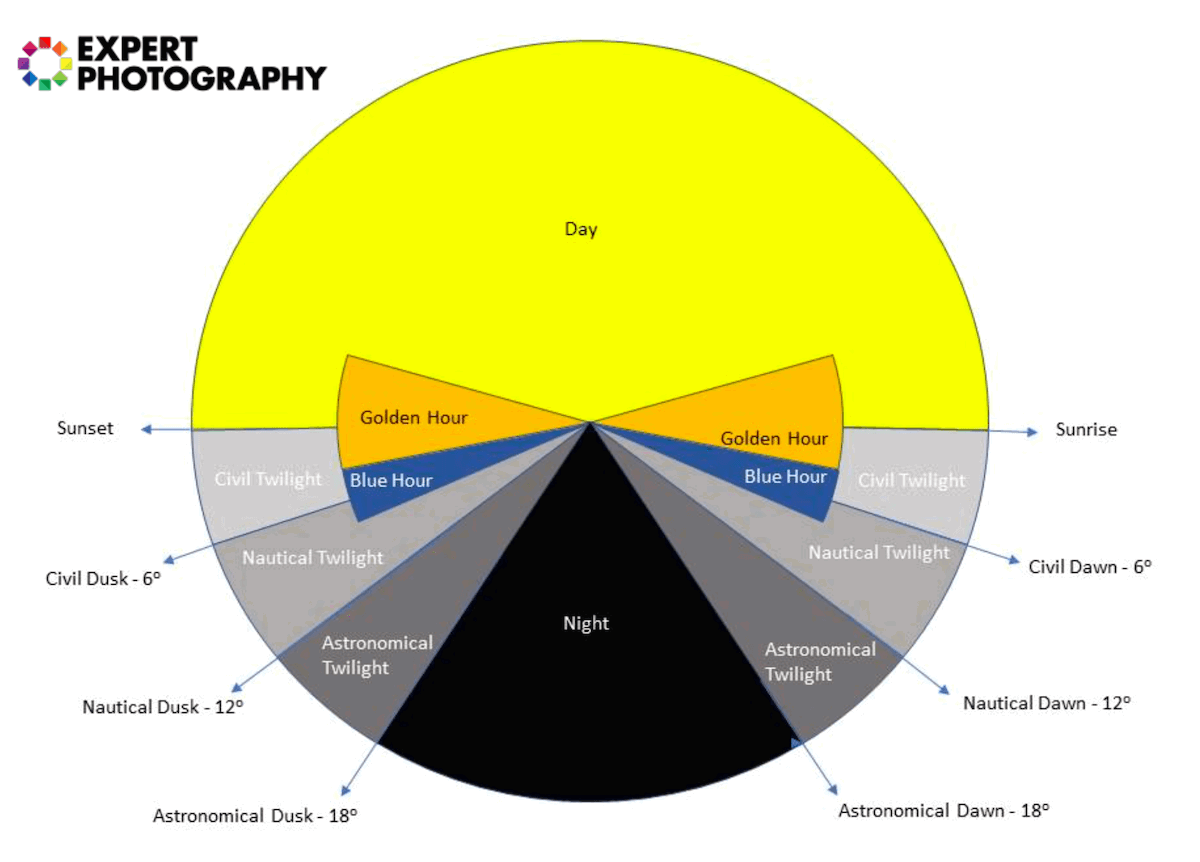
The best time to see the Milky Way is during the winter after astronomical twilight at dusk and before astronomical twilight at dawn.
What’s the Best Time of Year to See the Milky Way?
The best time of year to see the Milky Way is from March to September in the Northern Hemisphere (late spring to early autumn). Specifically, May, June, and July often offer the best views.
March to October (autumn and winter) is the best time in the Southern Hemisphere. April, May, June, and July are the best months.
You get the most interesting view of the Milky Way during these times. This is because of how the Earth spins around on its axis and how the angle changes in different seasons.
You may wonder, “If the Milky Way is the entire collection of stars, how does it change throughout the year?” It changes because the Milky Way has a core called the Galactic Center.
Its rotational center is surrounded by dust, gas, and stars. It’s the most intense and dramatic part of the Milky Way. So this is what you should aim to capture. It’s most prominent in the Northern Hemisphere in the late spring and early autumn, and winter in the Southern Hemisphere.
The most interesting angle of the Milky Way is when the Galactic Center is almost vertical to the horizon. This is when the stars look the brightest and the most intense.
The first photo below was taken in early April. The Milky Way is rising horizontally across the sky. Compare that to the second photo, taken in the summer. It’s almost vertical as it appears to rotate.
A trained eye can tell you when a photo was taken based on the position of the Milky Way. In the Northern Hemisphere, it starts horizontally in March and rotates 180 degrees through the months until September.
[imageblock]
[image src=”https://cdn.expertphotography.com/wp-content/uploads/2020/04/where-is-the-milky-way-horizontal-view-with-joshua-tree.jpeg” alt=”The Milky Way rising horizontally across the sky in the Northern Hemisphere” title=”Horizontal Milky Way”]
[image src=”https://cdn.expertphotography.com/wp-content/uploads/2020/04/where-is-the-milky-way-vertical-sky-view.jpeg” alt=”Screenshots of the Deluxe Moon and Sol apps to find the Milky Way showing a full moon phase and times of full darkness in Iceland” title=”Vertical Milky Way”]
[/imageblock]
What Does the Milky Way Look Like?
The simplest answer is to look at the sky and see how it looks. Sure, we only have one perspective of the Milky Way, but it’s the only one that matters to us!
Scientists use radio waves, infrared, and ultraviolet wavelengths to create a more accurate view of the Milky Way. (What it looks like from the “outside.”) To help get a closer view of the Miky Way, check out the best telescopes for astrophotography.
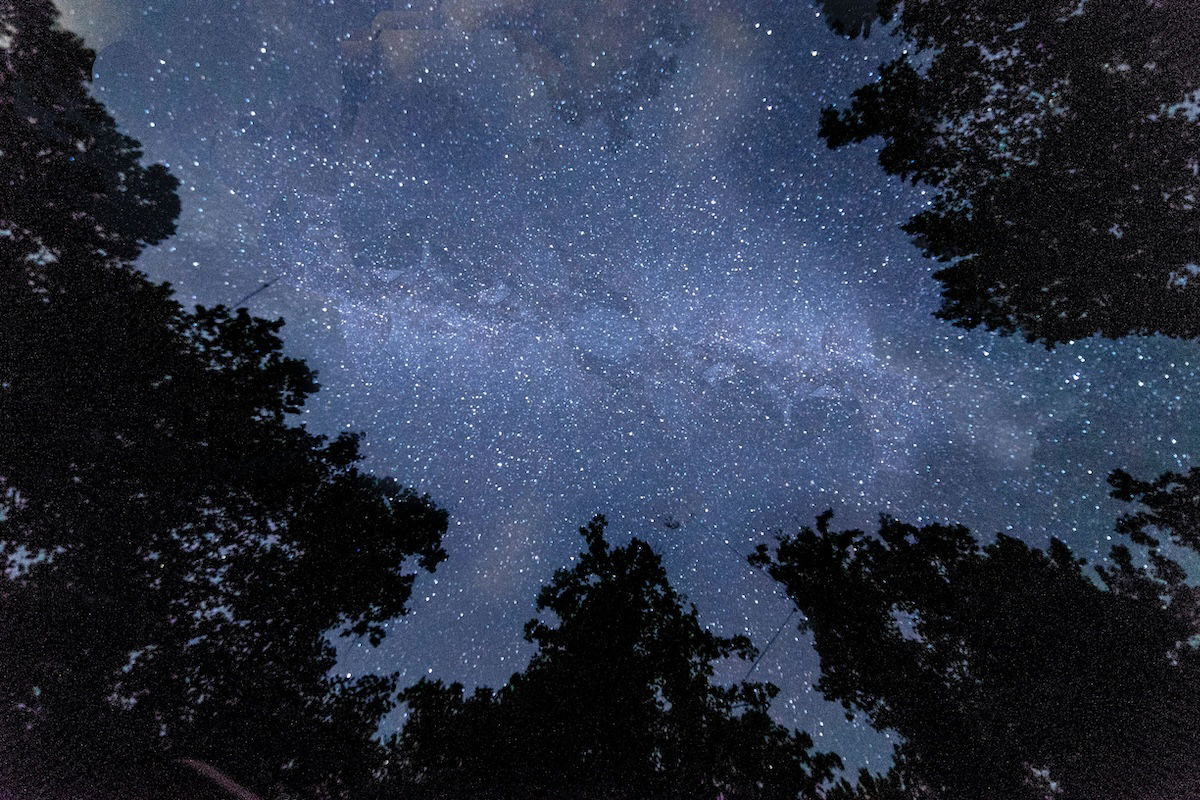
Shot with a Sony a7 II. 30 seconds, ISO 6,400. John Benitez (Unsplash)
How Do I Locate Polaris?
Finding the North Star isn’t that hard. And there are a couple of ways of doing it. You can “cheat” by using an app. There are many astronomy apps, like the following:
- GoSkyWatch Planetarium for iOS ($3.99)
- Stellarium Mobile for iOS or Android
- SkyView for iOS ($2.99) or Android ($1.99)
After downloading the app, you only need to point your phone at the night sky. It will align the stars with your compass and tell you precisely what you’re looking at.
The other way, my favorite method, is to do it the old-fashioned way. You can try to find the North Star by looking for the group of stars known as the Big Dipper.
The Big Dipper stands out because it resembles a garden scoop with a long handle (at the bottom of the picture below). If you follow the far edge of the scoop upwards, it points to Polaris, also known as the North Star. It is the first point on the Little Dipper’s “handle.”
I prefer this method because it helps you better understand the night sky and doesn’t require technology. Locating the North Star after dusk is crucial, as all other celestial bodies revolve around it.
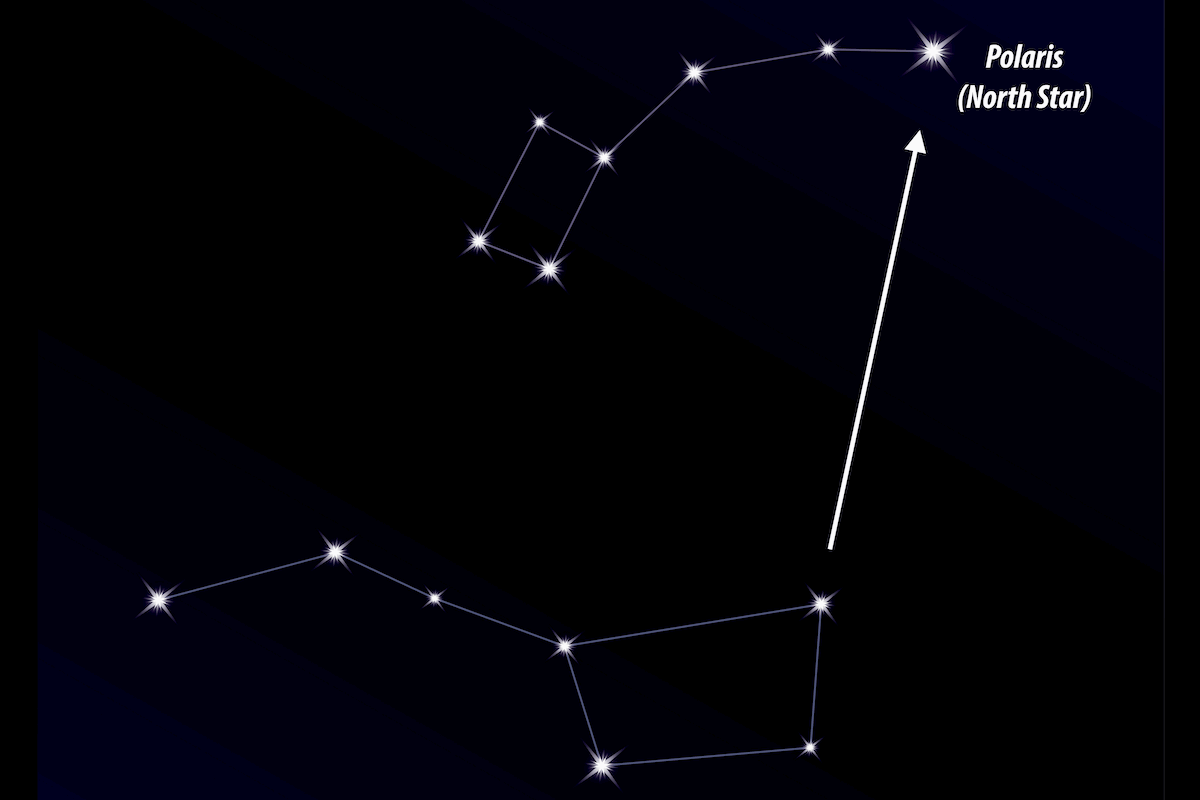
Big Dipper at the bottom and Little Dipper at the top
How Do I Find the Celestial South Pole?
To find the South Celestial Pole (SCP), you must locate the point around which the stars in the southern celestial hemisphere appear to rotate. Unlike the North Celestial Pole, the SCP has no bright star nearby to serve as a visual guide. But there are a few ways you can locate it:
- Use the Southern Cross (Crux): If you’re in the southern hemisphere, you can use the Southern Cross constellation (Crux) as a guide to find the SCP. Draw an imaginary line through the two celestial bodies at the long end of the cross. Then, extend this line about 4.5 times the distance between these two stars. This imaginary point is close to the SCP.
- Use the Magellanic Clouds: These two small satellite galaxies of the Milky Way are visible from the southern hemisphere. Draw an imaginary line connecting the two Magellanic Clouds and extend this line outward. The SCP lies approximately halfway along this line, slightly closer to the larger Magellanic Cloud.
- Use an Astronomy App or Start Chart: Like finding the North Star, you can use an astronomy app or a star chart to help locate the SCP. They display the positions of the stars and constellations in the sky. Then, you can identify the general direction of the SCP based on the surrounding stars.
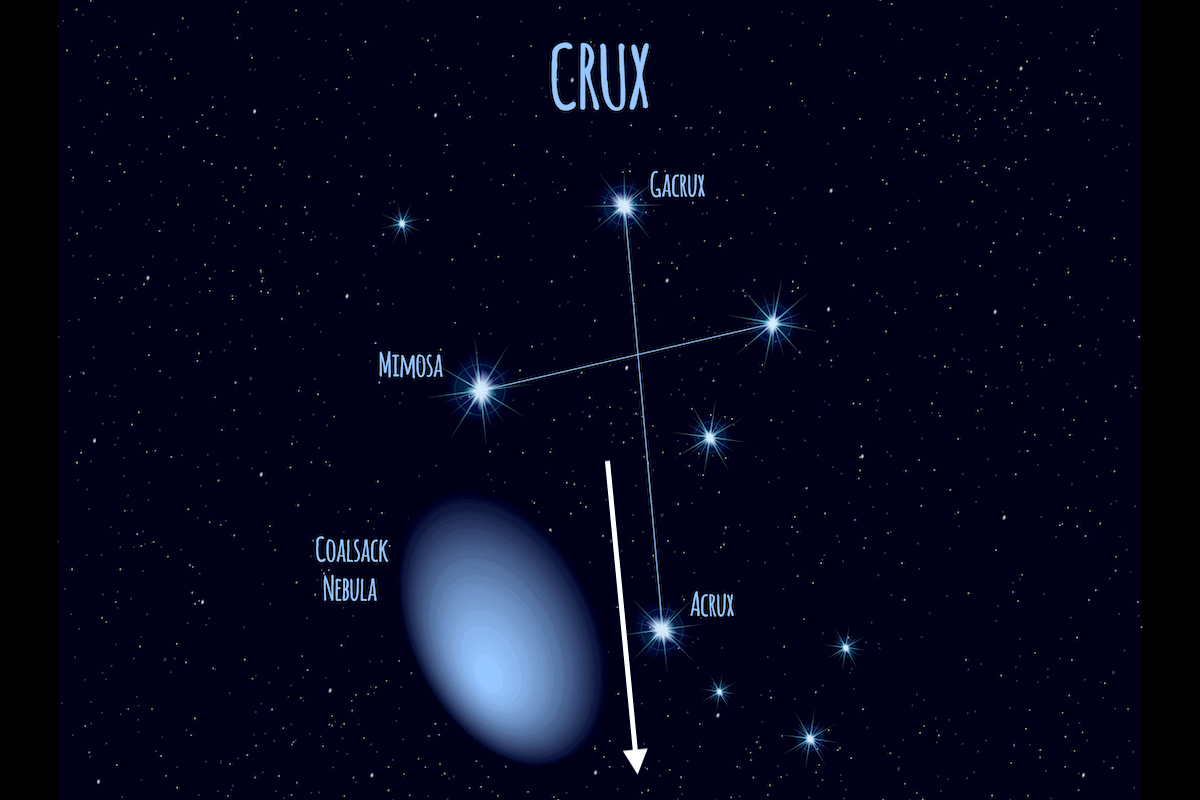
Extend this line between the Gacrux and Acrux 4.5 times to find the Celestial South Pole.
Conclusion: Finding the Way to the Milky Galaxy
What is the location of the Milky Way this evening? Finding the Milky Way isn’t too tough if you know what you’re doing. All you need is a dark, clear sky unobstructed by clouds, light pollution, or the moon.
You can easily spot the Milky Way if you know the optimal season to venture outside and when the sky is most devoid of light. As you’ve seen, many websites and apps help you figure this out. Now that you know how to locate our galaxy, you can take some amazing Milky Way time-lapses!
[highlight type=”short” price=”no” toc=”no” title=”Milky Way Mastery” badge=”Video Course” product=”30940″]Unlock the secrets of night sky photography with this video course:
- Learn to plan shots with optimal light, weather, and moon conditions.
- Discover the precise settings for stunning shots with any gear.
- Master simple editing techniques to enhance your night sky images.
[/highlight]